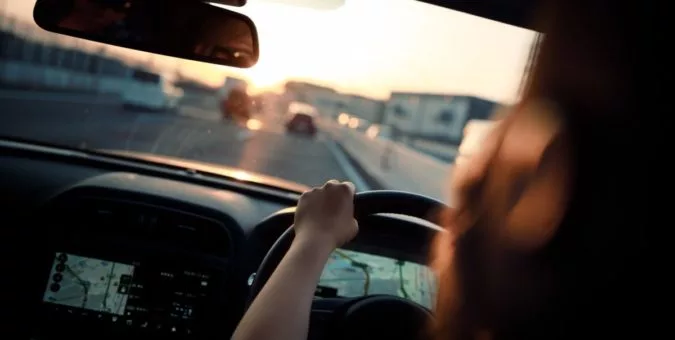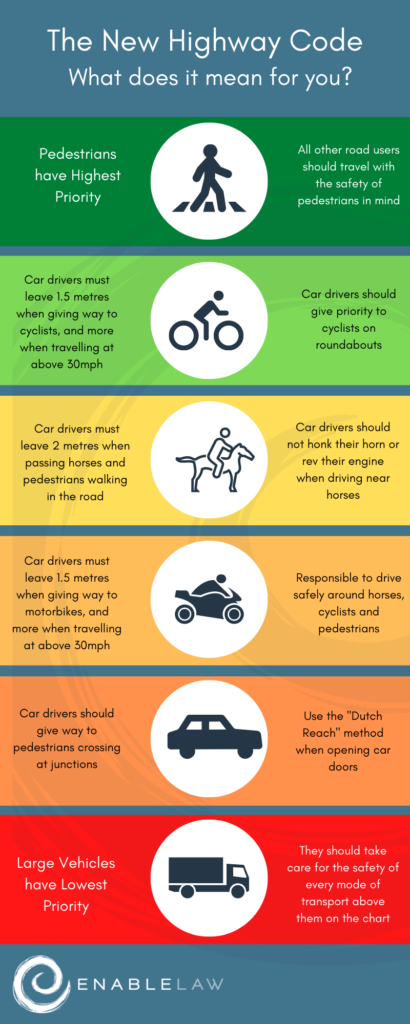
The Highway Code – a series of rules and regulations that set out how to drive in the UK –was subject to major changes on 29th January 2022, affecting all road users.
As a personal injury lawyer who happens to be a learner driver, I was particularly interested to find out about the changes, and how they affect car drivers. Here, I dig into the new Highway Code rules for car drivers, and what they could mean for future litigation.
What are the new Highway Code rules for drivers in 2022?
The latest edition of the Highway Code, released in 2022, is a guide published by the Department for Transport. It sets out what you must do to comply with UK driving laws – and there are a few changes for car drivers to keep in mind.
The main Highway Code changes are:
- The introduction of a new hierarchy of road users
- Updated passing distance guidelines
- New guidance on giving way, mobile phone use and exiting the car.
In the new hierarchy of road users, pedestrians are placed at the top, because they are the most vulnerable and most at risk in the event of a collision. Those able to cause the most harm bear greater responsibility to take care and reduce the danger to others.
In practice, this means, in the event of a collision, the party deemed the most dangerous may well be held liable, unless there is specific evidence to the contrary. The Code continues, however, to stress that all road users should behave responsibly, and have regard for their own and other’s safety.
The new Highway Code car rules mean drivers should, and in some cases, must:
Give way to pedestrians at junctions
One of the new Highway Code rules for car drivers is to give way to pedestrians waiting to cross a road into which, or from which, the driver is turning. This applies when a pedestrian has already started to cross at the junction, or if they are waiting to cross.
It is important to note the new Highway Code wording does not state a driver ‘must’ but ‘should’ – the should versus must distinction can shape whether the offence is legally binding. This suggests in circumstances where a driver judges it not safe to stop and give way, they do not have to do so.
The states that, in driving tests, failure to give way to a person clearly waiting to cross the road at a junction would normally be classed as a driving fault. Factors such as the presence of following traffic, the speed of the approach and actions of the person waiting to cross are also relevant, though.
This guidance suggests there are circumstances where a failure to give way won’t be penalised. The message to consider the road circumstances is something many learner drivers will recognise – but ambiguity could create some tension in future legal disputes.
Give space when passing cyclists
Car drivers must leave a space of 1.5 metres (5 feet) when overtaking cyclists, according to the Highway Code changes for 2022.
If it is not possible to meet these distances, the Code expects the driver to wait behind them and not overtake. Even as a novice driver, I can see how this may prove to be impractical particularly on narrow, rural roads, despite the idea behind it being inherently sensible.
Give space when passing horses and pedestrians
Another key Highway Code update relates to cars overtaking horse riders and pedestrians –car drivers must leave 2 metres (6.5 feet) between themselves and the rider.
This rule might apply when passing horse riders, a horse-drawn vehicle or pedestrians walking where there is no pavement.
Perform the ‘Dutch reach’ when opening doors
The Highway Code also contains new guidance for exiting a car, using a manoeuvre known as the ‘Dutch Reach’. This involves using the hand on the opposite side to the door to open the door. It forces the driver to look behind them as they open the door, with the aim of reducing the risk of hitting a passing cyclist with the door.
Cycling organisations like Cycling UK have campaigned in recent years to see this manoeuvre brought into law, following the death of a number of cyclists due to ‘car-dooring’.
The number of cyclists killed on UK roads increased from 134 in 2004 to 141 in 2020, a rise of 5%. More worrying is that, over the same period, there was an increase of 26% on the number of cyclists with serious injuries.
Teaching the ‘Dutch Reach’ to new drivers like me may well help the manoeuvre become the norm.
What other amendments to the Highway Code should I be aware of?
Some other key changes to the Highway Code impact:
Other Highway Code rules stay the same. For instance, when passing parked cars – car drivers have the right of way if the parked car is on the opposite side of the road, but not the same side.
The correct distance between overtaking cars isn’t specified in the Highway Code changes, since the new distances focus on the hierarchy concept.
A new ban on using mobile phones while driving
A move to prohibit drivers using their mobile phone for any purpose came into force on 25th March 2022.
The previous 2003 ban only covered using a mobile device to make a call or text – the new rule means taking photos, playing games and checking the time are also banned. This applies even when the car is stopped at traffic lights or queuing in traffic.
While mobile phones can still be used for satellite navigation, they need to be securely fixed into a cradle and not hand-held. There is also an exemption for drivers using their phone to make a contactless payment while stationary, for instance, paying for a car park or a drive-through coffee.
Research by the RAC found that had used their phone while driving to take a photo or video, perhaps mistakenly believing it less dangerous than making a phone call.
This update seeks to make it clear that using a mobile for any purpose is dangerous and distracting. The Highway Code also now makes it clearer that being stationary in traffic counts as driving and therefore the rules still apply.
A summary of Highway Code changes
| The Highway Code rules affected | Changes in 2022 |
| Rule H1 | All road users should be aware of the Highway Code. Drivers of large vehicles or cars have a responsibility to reduce risks to other road users, while cyclists and horse riders have a responsibility to pedestrians. |
| Rule H2 | Car drivers should give way to pedestrians who are crossing or waiting to cross at a junction where they are turning. |
| Rule H3 | Car drivers should not cut across cyclists or horse riders going straight ahead when turning their car at a junction. |
| Rule 8 | Pedestrians should look out for traffic turning at a junction and cross in a place where they are visible to drivers. |
| Rule 19 | Drivers and riders must give way to pedestrians on a zebra crossing. |
| Rules 62 and 63 | Cyclists should take care when passing pedestrians and allow plenty of room. Pass horse riders slowly and do not pass on their left. |
| Rule 67 | Cyclists should ride in the centre of the lane on quiet roads, and at least 0.5 metres from the kerb on busy roads. Cyclists should leave one metre when passing parked vehicles. |
| Rule 73 | Cyclists should proceed as if driving a car when using junctions with no bicycle lanes or lights. |
| Rule 74 | Cyclists should give way to pedestrians crossing at junctions. |
| Rule 75 | Cyclists should turn in two stages – first moving to on-road cycle markings – where signs dictate. |
| Rule 76 | Cyclists travelling straight ahead take priority over traffic waiting to turn unless road signs state otherwise. They should check turning is safe. |
| Rule 79 | Car drivers and motorbike riders should not overtake cyclists riding in their lane on a roundabout, and allow cyclists to cross their lane to exit. |
| Rule 163 | Car drivers should give motorcyclists, cyclists and horse riders at least as much space as they would give a car, and wait behind them if this is not possible. |
| Rule 212 | Car drivers should give more space when overtaking horses, motorbikes, cycles and horse-drawn vehicles in bad weather. |
| Rule 213 | Cyclists should sometimes ride in rows of two. They should leave at least one metre between themselves and parked cars. |
| Rule 239 | Where possible, car drivers should open doors using the hand furthest from the door. |
Are the new Highway Code rules legally binding?
While breaching the Highway Code is not in itself an offence, as it is an advisory document rather than law, many of the rules are also legal requirements, including the rules relating to mobile phone use.
This means that breaking the Highway Code could incur a fixed penalty fine and penalty points. For a new driver, this could mean losing their licence.
At least were killed on Britain’s roads in 2020 due to drivers distracted by mobile phones. This tightening up of the existing laws is therefore, long overdue. Some road safety campaigners even think the rules don’t go far enough. Using a hands-free device remains legal, for instance, when this could potentially be just as mentally distracting.
If you have been involved in a collision with a driver who you think was distracted, or who breached the Highway Code, but hasn’t been charged with an offence, you may well still be entitled to bring a personal injury claim.
However, speaking to a specialist solicitor, experienced in dealing with claims arising from road traffic incidents, could be a good idea – they will be able to give you sensible advice.




















